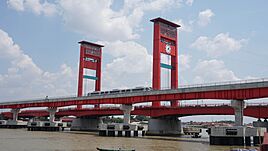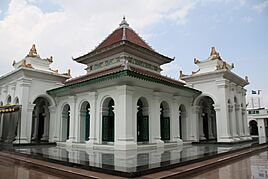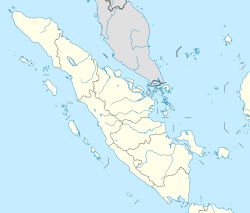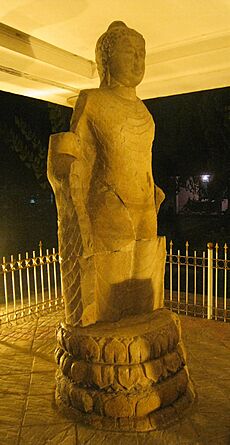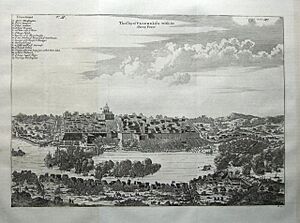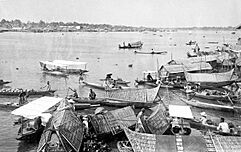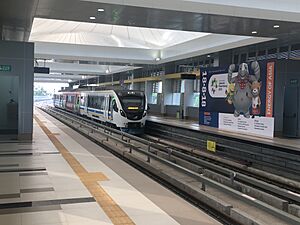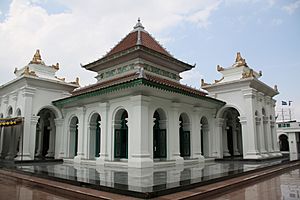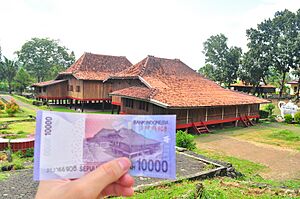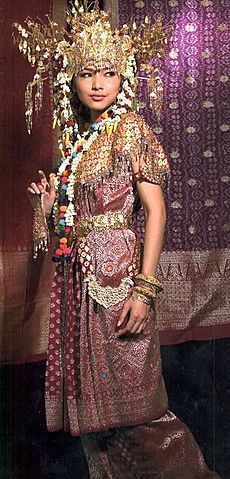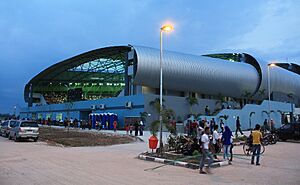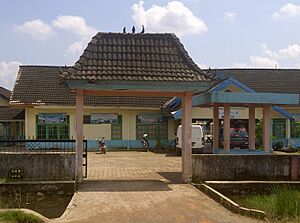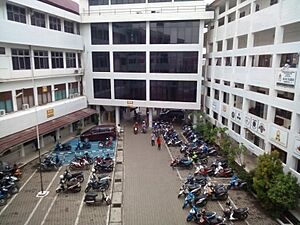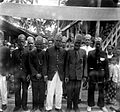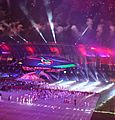Palembang facts for kids
Quick facts for kids
Palembang
Pelémbang (Palembang)
|
|||
|---|---|---|---|
|
City
|
|||
| City of Palembang Kota Palembang |
|||
|
Ampera Bridge
Sultan Mahmud Badaruddin II Museum
Gateway to the Cheng Ho Mosque
Sriwijaya Kingdom Archaeological Park
LRT Palembang
Great Mosque of Palembang
|
|||
|
|||
Nickname(s):
|
|||
| Motto(s):
Palembang BARI (Bersih, Aman, Rapi, Indah) (Palembang: Clean, Safe, Neat, and Beautiful)
|
|||
| Country | |||
| Region | Sumatra | ||
| Province | |||
| Founded | 16 June 683 (Kedukan Bukit Inscription) |
||
| Incorporated | 1 April 1906 (Staatsblad 1906:126) |
||
| Area | |||
| • City | 352.51 km2 (136.10 sq mi) | ||
| Elevation | 8 m (26 ft) | ||
| Population
(mid 2023 estimate)
|
|||
| • City | 1,772,492 | ||
| • Density | 5,028.20/km2 (13,022.99/sq mi) | ||
| • Metro | 2,706,835 | ||
| Demographics | |||
| • Ethnic groups |
|
||
| • Religion | Muslim 92.53% Buddhist 3.67% Protestant 2.23% Catholic 1.49% Hindu 0.06% |
||
| Time zone | UTC+7 (Indonesia Western Time) | ||
| Postal code |
301xx, 302xx
|
||
| Area code | (+62) 711 | ||
Palembang is a large city in Indonesia, located on the island of Sumatra. It is the capital of the South Sumatra province. Imagine a city built around a large river called the Musi River – that is Palembang! It is home to over 1.7 million people, making it the second-largest city on Sumatra, after Medan.
Palembang has a very long and interesting history. It used to be the capital of a powerful ancient kingdom called Srivijaya. This kingdom was very important for trade a long, long time ago.
In more recent times, Palembang has hosted big sports events. These include the 2011 Southeast Asian Games and the 2018 Asian Games (along with Jakarta). It even has Indonesia's first light rail system, which opened in 2018.
Contents
- What Does the Name Palembang Mean?
- Palembang's Long History
- Palembang's Geography and Climate
- How Palembang is Governed
- Palembang's People and Culture
- Getting Around Palembang
- Palembang's Economy and Business
- Sultan Mahmud Badaruddin II Museum
- Fun Things to See and Do in Palembang
- Palembang's Culture and Arts
- Sports in Palembang
- Learning in Palembang
- Palembang's Sister Cities
- Images for kids
- See also
What Does the Name Palembang Mean?
Some people think the name "Palembang" comes from the Malay word limbang. This word means "to pan for gold and diamonds". It is said that in ancient times, rulers made miners pan for gold and diamonds in the city. This was done for safety and to keep an eye on things.
Others believe the name comes from the Malay word lembang. With a special prefix, this means "a place where water leaks" or "a place often covered by water". This makes sense because Palembang is in a wetland area.
Another story says the name came from four brothers who survived a shipwreck near the Musi River. Their broken wooden box floated (limbang-limbang) until it reached land. They then named this land Palimbang.
In Chinese, Palembang is called Jùgǎng (Chinese: 巨港; literally "giant port"). In a Chinese dialect called Hokkien, it is called Kū-káng (舊港), which means "Old Port".
Palembang's Long History
Palembang has been an important city for over a thousand years.
The Ancient Srivijaya Kingdom
The oldest writing found in Palembang is the Kedukan Bukit Inscription, from 682 AD. It tells a story of a king who gained special powers. He led a large army by water and land, starting from a delta. Many believe this led to the founding of the Srivijaya kingdom.
Srivijaya was a powerful Buddhist kingdom. It controlled much of the western Indonesian Archipelago. It also managed many important trade routes, like the Strait of Malacca. Traders from China and India would stop in Srivijaya. They had to wait for the winds to change direction. This made Srivijaya a huge international trade center. It also became a cultural hub. A Chinese Buddhist traveler named Yijing visited in 671. He wrote that over a thousand Buddhist monks and scholars studied in Palembang.
Around 990, an army from the Mataram Kingdom in Java attacked Srivijaya. Palembang was damaged, and the palace was looted. However, Srivijaya fought back and pushed them away by 1006.
Later, in 1068, an Indian kingdom called the Chola Dynasty attacked Srivijaya. This weakened the kingdom. Its lands began to break away and form smaller kingdoms. Srivijaya finally declined after military attacks from Javanese kingdoms in the 13th century.
After Srivijaya: Pirates and New Rulers
After Srivijaya, Palembang faced problems with pirates. One famous pirate was Chen Zuyi. In 1407, a Chinese admiral named Zheng He arrived. He defeated the pirates and captured Chen Zuyi. This brought peace back to the area. A new ruler, Shi Jinqing, was put in charge of Palembang.
The Palembang Sultanate
A new dynasty started in Palembang when a nobleman named Geding Suro arrived. During this time, Islam became the main religion in Palembang. The Sultanate of Palembang was officially formed in 1659. The Great Mosque of Palembang was built between 1738 and 1748.
Houses grew along the Musi River. Some were even built on rafts! The Sultanate had a rule: only Palembang citizens could live on one side of the river (Seberang Ilir). Others had to live on the opposite bank (Seberang Ulu).

The Dutch East India Company set up a trading post in Palembang in 1619. They gained control over the pepper trade. Tensions grew between the Dutch and the local people. In 1659, the Dutch attacked and burned the city.
During the Napoleonic Wars in 1812, the British took control of Palembang. They removed the Sultan and put his younger brother in charge. Later, the Dutch tried to regain their power. They exiled Sultan Mahmud Badaruddin II and burned his palace. The Sultanate was eventually ended by the Dutch, and they ruled Palembang directly.
Dutch Colonial Rule
After the Dutch took full control in 1825, Palembang became the capital of the Palembang Residency. This area later became the South Sumatra province.

In the late 1800s, Palembang grew as an economic center. New crops like coffee were introduced. In the early 1900s, the oil and rubber industries helped the city's economy boom. Many people moved to Palembang, and the city grew quickly. It became the most populated city outside of Java.
Japanese Occupation During World War II
During World War II, Palembang was very important because of its oil refineries. The Japanese forces wanted to capture it. The main battle happened from February 13-16, 1942. Japanese paratroopers landed to try and take control of the airfields and oil refineries.
The Japanese managed to get control of one oil refinery. Although the Allies tried to destroy the refineries, some were still usable. The Japanese were able to restart oil production, which was very important for their war efforts.
Later, in 1945, the British Royal Navy launched major attacks on the refineries. This reduced the fuel output significantly.
Palembang in Modern Indonesia
After Indonesia declared independence, Palembang became part of the new nation. There was a battle with Dutch forces in January 1947, known as the "Five Days and Nights Battle".
In 1962, the construction of the Ampera Bridge began. This famous bridge was opened in 1965. It connects the two main parts of Palembang across the Musi River.
Palembang has grown a lot. In 1988, its administrative area expanded. The city has also hosted many major sports events. A large sports complex, Jakabaring Sport City, was built. Palembang hosted the National Games in 2004 and co-hosted the 2011 Southeast Asian Games and the 2018 Asian Games.
To improve transportation, Palembang built Indonesia's first light rail transit system in 2018. This connects the airport to the sports complex.
Palembang's Geography and Climate
Where is Palembang Located?
Palembang is located in a large lowland area in southern Sumatra. It is about 105 kilometers (65 miles) from the coast. The Musi River flows through the city, dividing it into two main parts: Seberang Ilir (north) and Seberang Ulu (south). Two other rivers, the Ogan River and Komering River, also join the Musi River here.
The river's water level changes with the tides. During the rainy season, many parts of the city can get flooded. Seberang Ulu is mostly flat, while Seberang Ilir has more varied land with small hills.
Palembang's Tropical Climate
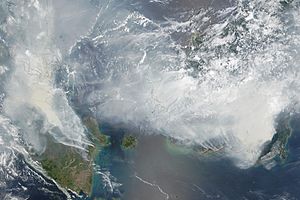
Palembang has a tropical rainforest climate. This means it is hot and humid with a lot of rain all year round. The average temperature is about 27.3°C (81.1°F).
The city gets a lot of rainfall, about 2,623 mm (103 inches) each year. In the wettest months, heavy rains can flood low-lying areas. However, in the driest months, the surrounding peatlands can dry out. This makes them prone to wildfires, which can cause thick haze in the city.
| Climate data for Palembang (Sultan Mahmud Badaruddin II International Airport, 1991–2020 normals) | |||||||||||||
|---|---|---|---|---|---|---|---|---|---|---|---|---|---|
| Month | Jan | Feb | Mar | Apr | May | Jun | Jul | Aug | Sep | Oct | Nov | Dec | Year |
| Record high °C (°F) | 36.8 (98.2) |
35.4 (95.7) |
35.6 (96.1) |
35.2 (95.4) |
35.4 (95.7) |
35.1 (95.2) |
35.9 (96.6) |
35.4 (95.7) |
36.2 (97.2) |
36.8 (98.2) |
36.6 (97.9) |
35.3 (95.5) |
36.8 (98.2) |
| Mean daily maximum °C (°F) | 30.9 (87.6) |
31.4 (88.5) |
32.1 (89.8) |
32.5 (90.5) |
32.6 (90.7) |
32.3 (90.1) |
32.2 (90.0) |
32.8 (91.0) |
33.2 (91.8) |
33.0 (91.4) |
32.3 (90.1) |
31.3 (88.3) |
32.2 (90.0) |
| Daily mean °C (°F) | 26.5 (79.7) |
26.5 (79.7) |
26.9 (80.4) |
27.2 (81.0) |
27.5 (81.5) |
27.3 (81.1) |
27 (81) |
27.2 (81.0) |
27.3 (81.1) |
27.3 (81.1) |
27.1 (80.8) |
26.7 (80.1) |
27.0 (80.6) |
| Mean daily minimum °C (°F) | 23.4 (74.1) |
23.4 (74.1) |
23.4 (74.1) |
23.7 (74.7) |
24.2 (75.6) |
23.7 (74.7) |
23.2 (73.8) |
23.0 (73.4) |
23.0 (73.4) |
23.2 (73.8) |
23.5 (74.3) |
23.4 (74.1) |
23.4 (74.1) |
| Record low °C (°F) | 20.2 (68.4) |
19.7 (67.5) |
20.0 (68.0) |
20.6 (69.1) |
20.8 (69.4) |
20.4 (68.7) |
19.8 (67.6) |
18.8 (65.8) |
19.2 (66.6) |
20.4 (68.7) |
19.4 (66.9) |
19.4 (66.9) |
18.8 (65.8) |
| Average precipitation mm (inches) | 267.2 (10.52) |
245.8 (9.68) |
350.0 (13.78) |
300.2 (11.82) |
174.3 (6.86) |
148.3 (5.84) |
107.6 (4.24) |
80.5 (3.17) |
100.0 (3.94) |
224.4 (8.83) |
316.9 (12.48) |
345.4 (13.60) |
2,660.6 (104.75) |
| Average precipitation days (≥ 1.0 mm) | 18.7 | 14.5 | 17.7 | 17.2 | 12.1 | 9.5 | 9.2 | 7.6 | 8.0 | 13.2 | 16.8 | 18.8 | 163.3 |
| Mean monthly sunshine hours | 110.1 | 113.4 | 133.2 | 150.7 | 162.2 | 152.1 | 172.1 | 179.9 | 151.1 | 135.0 | 124.8 | 105.8 | 1,690.4 |
| Source: World Meteorological Organization | |||||||||||||
Palembang's Neighborhoods
The Musi River divides Palembang into two main areas: Seberang Ilir (the "downstream bank") in the north and Seberang Ulu (the "upstream bank") in the south. Seberang Ilir is the main business and political center. It has many of the city's tall buildings. Seberang Ulu is developing quickly, especially in Jakabaring. This area has new business centers, government buildings, and the city's large sports complex.
How Palembang is Governed
City Districts
Palembang is made up of 18 kecamatan (districts). Each district is led by a Camat. These districts are further divided into 107 kelurahan (urban villages).
| Kode Wilayah |
Name of District (kecamatan) |
Area in km2 |
Pop'n census 2010 |
Pop'n census 2020 |
Pop'n estimate mid 2023 |
Density (per km2) in 2023 |
No. of kelurahan |
Postal codes |
|---|---|---|---|---|---|---|---|---|
| 16.71.01 | Ilir Barat Dua | 4.18 | 63,959 | 67,614 | 69,665 | 16,666.3 | 7 | 30141 - 30146 |
| 16.71.12 | Gandus | 49.64 | 57,221 | 73,953 | 81,146 | 1,634.7 | 5 | 30147 - 30149 |
| 16.71.02 | Seberang Ulu Satu | 6.09 | 162,744 | 91,166 | 94,662 | 15,543.8 | 6 | 30258 - 30259 |
| 16.71.13 | Kertapati | 41.09 | 80,226 | 91,661 | 98,434 | 2,395.6 | 5 | 30251 - 30257 |
| 16.71.17 | Jakabaring | 11.72 | (a) | 90,415 | 93,830 | 8,006.0 | 5 | 30251 - 30257 |
| 16.71.03 | Seberang Ulu Dua | 8.35 | 92,276 | 100,232 | 105,784 | 12,668.7 | 7 | 30261 - 30267 |
| 16.71.14 | Plaju | 16.52 | 79,096 | 93,171 | 98,426 | 5,958.0 | 7 | 30266 - 30268 |
| 16.71.04 | Ilir Barat Satu | 40.15 | 124,657 | 140,945 | 151,894 | 3,783.2 | 6 | 30131 - 30134 |
| 16.71.11 | Bukit Kecil | 2.38 | 43,811 | 38,585 | 38,226 | 16,061.3 | 6 | 30135 - 30136 |
| 16.71.05 | Ilir Timur Satu | 5.16 | 69,406 | 66,168 | 66,260 | 12,841.1 | 11 | 30121 - 30124 |
| 16.71.09 | Kemuning | 6.51 | 82,661 | 80,685 | 81,977 | 12,592.5 | 6 | 30127 - 30128 |
| 16.71.06 | Ilir Timur Dua | 8.53 | 159,152 | 85,460 | 84,949 | 9,958.9 | 6 | 30111 - 30118 |
| 16.71.10 | Kalidoni | 32.97 | 99,738 | 122,474 | 130,828 | 3,968.1 | 5 | 30114 - 30119 |
| 16.71.18 | Ilir Timur Tiga | 7.84 | (a) | 73,010 | 74,431 | 9,493.8 | 6 | 30111 - 30114 |
| 16.71.08 | Sako | 15.56 | 82,661 | 110,079 | 115,585 | 7,428.3 | 4 | 30161 - 30164 |
| 16.71.16 | Sematang Borang | 24.79 | 32,207 | 54,362 | 67,447 | 2,720.7 | 4 | 30161 - 30165 |
| 16.71.07 | Sukarami | 47.23 | 139,098 | 183,667 | 205,370 | 4,348.3 | 7 | 30151 - 30155 |
| 16.71.15 | Alang-Alang Lebar | 23.26 | 86,371 | 105,201 | 113,578 | 4,883.0 | 4 | 30151 - 30154 |
| 16.71 | Totals | 352.51 | 1,455,284 | 1,668,848 | 1,772,492 | 5,028.2 | 107 |
Note: (a) Two new districts, Ilir Timur Tiga and Jakabaring, were created in 2017. Their 2010 populations are counted in the districts they were split from.
Palembang's People and Culture
Who Lives in Palembang?
| Religion in Palembang (2017) | ||||
|---|---|---|---|---|
| religion | percent | |||
| Islam | 92.52% | |||
| Buddhism | 3.67% | |||
| Protestant | 2.23% | |||
| Roman Catholic | 1.49% | |||
| Hinduism | 0.06% | |||
| Confucianism | 0.02% | |||
Palembang is a city with many different groups of people. The original people of Palembang are called Palembang people. Many of them live in traditional homes along the Musi River.
You will also find people from other parts of South Sumatra. There are also many Javanese, Minangkabau, Arab, Indian, and Chinese communities. For example, Arab Indonesian communities live in villages like Kampong Al Munawwar. Chinese Indonesian communities mostly live in business areas.
Languages Spoken in Palembang
The local language of Palembang is called Musi (Baso Plembang). It is a dialect of Malay. It has many words borrowed from the Javanese language. People from other parts of South Sumatra also speak their own languages. Chinese languages are also used by local Chinese communities.
Religions in Palembang
Palembang officially recognizes six religions. Most people in Palembang are Muslim (92.22%). Other religions include Buddhist (3.91%), Protestant (2.23%), Roman Catholic (1.49%), Hindu (0.13%), and Confucianist (0.02%).
There are several old and important mosques in Palembang. The main one is the Great Mosque of Palembang. It was built during the time of the Palembang Sultanate.
Getting Around Palembang
In the past, many people in Palembang used water transportation. Large riverboats carried people and goods. Smaller boats, like the traditional Kajang boat, were also common. Today, most people prefer to travel by road. They often use private cars or public transport. Traffic jams can happen on main streets, especially during busy times.
Road Transport
Toll Roads
Since 2020, Palembang has been connected to the Trans-Sumatra Toll Road. This road links it to other cities in Sumatra.
Public Buses and Taxibuses
Palembang has several bus and taxibus (angkot) routes. In the past, angkots were called "Mobil Ketek" because of their engine sound. Today, most public bus services are provided by Teman Bus. They run four main routes in the city.
Teman Bus also operates air-conditioned taxibuses. These act as feeder routes for the Palembang LRT service. Another bus company, DAMRI, runs routes to nearby towns.
Taxis, Pedicabs, and Motorcycle Taxis
Palembang has many taxis. Their number increased after the National Games in 2004 and the SEA Games in 2011. You can also find becak (pedicabs) and ojek (motorcycle taxis). Becak are more common in older areas near the Musi River. Ojek are found more in newer parts of the city.
You can also use app-based taxi and ojek services like Go-Jek and Grab.
Rail Transport
Railway tracks were first built by the Dutch in the late 1800s. These tracks connect Palembang to other provinces in southern Sumatra. They also link to main towns within South Sumatra. The largest railway station in Palembang is Kertapati Station. There are plans to connect Palembang to more cities across Sumatra.
Palembang was the first Indonesian city to have a light rail system. The Palembang LRT opened on August 1, 2018. It has 13 stations and connects the Sultan Mahmud Badaruddin II International Airport to Jakabaring Sport City.
Water Transport
River Boats
Palembang has different types of river transportation. The traditional "perahu ketek" is a slow wooden motorboat. People living by the river use it to cross from one bank to another. "Speedboats" are faster wooden motorboats. They are often used by people from outside Palembang to travel to and from the city. Palembang also has larger riverboats for tourism.
Ports
Palembang has two main ferry ports: Tanjung Api-api Port and Boom Baru Port. These ports offer ferry services to Bangka, Belitung, and Batam Island. There are plans to build a deeper sea port at Tanjung Api-Api.
Air Travel
The only public airport in Palembang is Sultan Mahmud Badaruddin II International Airport. It has flights to many cities in Indonesia, especially Jakarta. It also has international flights to Singapore and Kuala Lumpur.
Palembang's Economy and Business
Palembang's economy relies heavily on trading, services, transportation, manufacturing, and construction. It is a major business center in southern Sumatra.
Many important factories and industries operate in Palembang. These include a fertiliser factory (Pupuk Sriwidjaja Palembang), a portland cement factory (Baturaja Portland Cement), and oil and gas refineries (Pertamina). Coal from mines in South Sumatra is also transported to Palembang. From here, it is shipped to Java or other countries.
South Sumatra is the largest producer of rubber in Indonesia. A lot of rubber is exported from Palembang each year. The city has many rubber processing factories.
Tourism is also growing in Palembang. Many hotels have opened, especially after the 2004 Pekan Olahraga Nasional. Palembang is also famous for its food. A ton of pempek (a local dish) is sent from Palembang to other cities and countries every day!
Markets and Shopping Areas
Palembang has two main types of markets: traditional and modern. Most of the 30 traditional markets are managed by PD Pasar Palembang Jaya. The 16 Ilir Market is the main traditional market in the city. The area around it is a busy commercial center. Another notable traditional market is Cinde Market, one of the oldest in Indonesia.
Modern shopping centers and malls are also found throughout the city. Some of the main ones include Palembang Indah Mall, Palembang Icon, and Palembang Square.
Sultan Mahmud Badaruddin II Museum
The Sultan Mahmud Badaruddin II Museum in Palembang houses many interesting archaeological objects. These objects come from sites in the region that have been excavated. The museum is located in what used to be the Dutch-era resident office. This building was once the royal palace of the Palembang Sultanate. The museum shows relics and historical items from the Srivijaya Kingdom to the Palembang Sultanate era.
Fun Things to See and Do in Palembang
Palembang is known as Venetië Van Andalas (Venice of Sumatra). This is because the city has many rivers and waterways, especially the Musi River.
Palembang's culture and language have been influenced by many different civilizations, including Chinese, Javanese, and Arab cultures. You can also see Dutch architectural styles in the city.
The most famous landmarks in Palembang are the Ampera Bridge, the Musi River, Kuto Besak Fort, Kemaro Island, and Jakabaring Sport City.
Famous Landmarks and Sights
- Musi River: This 750 km (466 mi) long river divides Palembang into two parts. It has always been the heart of Palembang's economy. Along its banks, you can see the Ampera Bridge, Kuto Besak Fort, and traditional raft houses.
- Ampera Bridge: This is the city's main landmark. It is a long bridge (1,177 meters or 3,862 feet) that crosses the Musi River. It connects the Seberang Ulu and Seberang Ilir areas.
- Great Mosque of Palembang: Also known as the Sultan Mahmud Badaruddin II Mosque, this is the main mosque in the city center. It was built as the royal mosque of the Palembang Sultanate.
- Kuto Besak Fort: This fort is on the northern bank of the Musi River. It was built by the Palembang Sultanate. It is one of the few forts built by local people, not by Europeans. Today, it is a military hospital, so visitors can only see it from the outside.
- Kemaro Island: This small island in the Musi River has Chinese heritage sites. These include the Kemaro Island Pagoda and the Hok Tjiang Rio temple. It becomes very busy during Chinese festivals like Cap Go Meh.

- Kampong Arab Al-Munawar: This village is home to descendants of Arab Indonesians. It is known for its unique architecture and culture, which mixes local Malay and Arab styles.
- Kampong Kapitan: One of the oldest Chinese villages in the city. You can see Tjoa Ham Hin's house with furniture that is centuries old. There is also an old Chinese temple nearby.
- Kambang Iwak: A pond near the mayor's residence. During Dutch rule, this area was where Dutch people lived. Today, it is a park and recreation area, popular with locals on weekends.
- Punti Kayu Tourism Forest: A city forest about 6 kilometers (3.7 miles) from the city center. It is a protected forest with a family recreation area. You might see long-tailed macaques and other monkeys here.
- Sriwijaya Kingdom Archaeological Park: This park has the remains of the ancient Srivijaya site. You can find old inscriptions, stone relics, and ancient ponds here. The Srivijaya Museum is also in this complex.
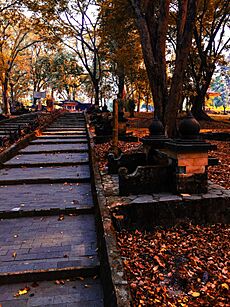
- Bukit Seguntang archaeological park: Located on hills west of Palembang. This is a very important historical area for the Malay community. It is believed that Sang Sapurba, the ancestor of many Malay kings, came from this hill. It is now a recreational park.
- Monumen Perjuangan Rakyat / Monpera (People Struggle Monument): Located in the city center. This monument displays items from the Indonesian National Revolution in South Sumatra.
- Museum Balaputradewa: This museum is home to the Rumah Limas, a traditional Palembang house featured on the IDR 10000 banknote.
- Al-Qur'an Al-Akbar: The Grand Quran of Palembang. This is a giant, five-story replica of the Muslim holy book. It is a very important religious site.
Festivals in Palembang
- Bidar race: A traditional Malay rowing tournament held twice a year on the Musi River. It often takes place on August 17 (Indonesia's Independence Day). Teams race across the river, and there is also a boat carnival.
- Ziarah Kubro: A tradition where thousands of Muslims visit the tombs of important leaders and scholars of the Palembang Sultanate. This happens before the holy month of Ramadan.
Palembang's Culture and Arts
Palembang has always been a major port city. This means it has taken in many different cultures and influences over time. Its culture and language are a mix of Malay and Javanese customs. For example, the word "wong" (person) in the Palembang language comes from Javanese.
Delicious Palembang Cuisine
Palembang cuisine is very famous in Sumatra. It mainly uses freshwater fish and prawns because the Musi River is so important to the area. Spices are used, but not as much as in some other Sumatran dishes. Malay, Indian, and Chinese cultures have also influenced Palembang's food.
Some of the most well-known dishes include pempek, tekwan, pindang patin, and martabak HAR. Many Palembang dishes are influenced by Chinese cooking.
Palembang's Arts
Beautiful Textiles
Palembang is famous for its artistic fabric called songket. This is a special hand-woven fabric made with gold or silver threads. It is a luxury item often worn during ceremonies. In the past, it was used by the Srivijaya court and Malay royal families. Traditionally, women weave songket, but men also do it now. There are six main patterns in Palembang songket. These patterns are also used to decorate buildings in Palembang.
Woodcarving
Palembang is also known for its woodcarving. Palembang woodcarvings are influenced by Chinese culture. They often feature designs like jasmine or lotus flowers. Originally, this style was used for wardrobes that stored songket fabrics. Today, you can see it on house decorations, furniture, and other items.
Traditional Dances
Folk dances have been performed in Palembang for a very long time. The most famous is the Tanggai Dance. In the past, it was considered sacred and performed as an offering. Now, it is performed at important ceremonies and weddings.
Theatrical Performances
Sometimes, for special events, people in Palembang perform a traditional play called Dulmuluk. It is named after its main character, Raja Abdulmuluk Jauhari. Dulmuluk started as a poem and was turned into a play in 1910. These performances often last all night until dawn.
Sports in Palembang
Palembang is well-known for hosting major sports events. It was one of the host cities for the 2018 Asian Games. It was also the main host for the 2011 Southeast Asian Games. The city has built many sports facilities, especially the large Jakabaring Sport City complex.
To keep the sports complex busy, the government encourages more sporting events. They even bought a football club, Persijatim Solo F.C., in 2004 and renamed it Sriwijaya F.C.. Palembang also plans to build a race track to host a MotoGP race.
Football is the most popular sport in Palembang. Sriwijaya F.C. is the only professional football club in South Sumatra. Its home games are very popular, with fans wearing yellow, green, and black shirts. Other popular sports include Badminton, basketball, volleyball, and futsal. Famous badminton players like Mohammad Ahsan and Debby Susanto are from Palembang.
Learning in Palembang
Palembang has many schools at all levels. There are 462 elementary schools, 243 junior high schools, 140 high schools, and 80 vocational schools. Most of these are privately owned. There are also 26 Islamic boarding schools (pesantren).
Christian and Buddhist schools are also available. Many study centers help students prepare for exams.
Palembang has several universities and colleges. These include Sriwijaya University, Raden Fatah State Islamic University, and Sriwijaya State Polytechnic.
Palembang's Sister Cities
Palembang has special partnerships with other cities around the world. These are called twin towns or sister cities.
 Zhangzhou, China (since 2002)
Zhangzhou, China (since 2002) Iloilo City, Philippines (since 2016)
Iloilo City, Philippines (since 2016) Venice, Italy
Venice, Italy Moscow Oblast, Russia
Moscow Oblast, Russia Neiva, Colombia
Neiva, Colombia
Images for kids
See also
 In Spanish: Palembang para niños
In Spanish: Palembang para niños


